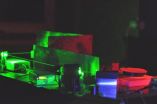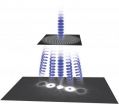(Press-News.org) The quantum computers of tomorrow might use photons, or particles of light, to move around the data they need to make calculations, but photons are tricky to work with. Two new papers* by researchers working at the National Institute of Standards and Technology (NIST) have brought science closer to creating reliable sources of photons for these long-heralded devices.
In principle, quantum computers can perform calculations that are impossible or impractical using conventional computers by taking advantage of the peculiar rules of quantum mechanics. To do this, they need to operate on things that can be manipulated into specific quantum states. Photons are among the leading contenders.
The new NIST papers address one of the many challenges to a practical quantum computer: the need for a device that produces photons in ready quantities, but only one at a time, and only when the computer's processor is ready to receive them. Just as garbled data will confuse a standard computer, an information-bearing photon that enters a quantum processor together with other particles—or when the processor is not expecting it—can ruin a calculation.
The single-photon source has been elusive for nearly two decades, in part because no method of producing these particles individually is ideal. "It's a bit like playing a game of whack-a-mole, where solving one problem creates others," says Alan Migdall of NIST's Optical Technology Division. "The best you can do is keep all the issues under control somewhat. You can never get rid of them."
The team's first paper addresses the need to be certain that a photon is indeed coming when the processor is expecting it, and that none show up unexpected. Many kinds of single-photon sources create a pair of photons and send one of them to a detector, which tips off the processor to the fact that the second, information-bearing photon is on its way. But since detectors are not completely accurate, sometimes they miss the "herald" photon—and its twin zips into the processor, gumming up the works.
The team effort, in collaboration with researchers from the Italian metrology laboratory L'Istituto Nazionale di Ricerca Metrologica (INRIM), handled the issue by building a simple gate into the source. When a herald photon reaches the detector, the gate opens, allowing the second photon past. "You get a photon when you expect one, and you don't get one when you don't," Migdall says. "It was an obvious solution; others proposed it long ago, we were just the first ones to build it. It makes the single photon source better."
In a second paper, the NIST team describes a photon source to address two other requirements. Quantum computers will need many such sources working in parallel, so sources must be able to be built in large numbers and operate reliably; and so that the computer can tell the photons apart, the sources must create multiple individual photons, but all at different wavelengths. The team outlines a way to create just such a source out of silicon, which has been well-understood by the electronics industry for decades as the material from which standard computer chips are built.
"Ordinarily a particular material can produce only pairs in a specific pair of wavelengths, but our design allows production of photons at a number of regular and distinct wavelengths simultaneously, all from one source," Migdall says. "Because the design is compatible with microfabrication techniques, this accomplishment is the first step in the process of creating sources that are part of integrated circuits, not just prototype computers that work in the hothouse of the lab."
INFORMATION:
* G. Brida, I. P. Degiovanni1, M. Genovese, A. Migdall, F. Piacentini, S. V. Polyakov and I. Ruo Berchera. Experimental realization of a low-noise heralded single-photon source. Optics Express, Jan. 14, 2011, pp. 1470 – 1483. DOI: 133913.
J. Chen, Z.H. Levine, J. Fan and A.L. Migdall. Frequency-bin entangled comb of photon pairs from a Silicon-on-Insulator micro-resonator. Optics Express, Jan. 14, 2011, pp. 1484 – 1492. DOI: 133346.
NIST advances single photon management for quantum computers
2011-01-21
ELSE PRESS RELEASES FROM THIS DATE:
Real-world graphene devices may have a bumpy ride
2011-01-21
Electronics researchers love graphene. A two-dimensional sheet of carbon one atom thick, graphene is like a superhighway for electrons, which rocket through the material with 100 times the mobility they have in silicon. But creating graphene-based devices will be challenging, say researchers at the National Institute of Standards and Technology (NIST), because new measurements show that layering graphene on a substrate transforms its bustling speedway into steep hills and valleys that make it harder for electrons to get around.
In a new article in Nature Physics,* NIST ...
Stretching the truth: JILA biophysicists help unravel DNA stretching mystery
2011-01-21
Using a new experimental test structure, biophysicists at JILA have unraveled part of a 15-year mystery in the mechanics of DNA—just how the molecule manages to suddenly extend to almost twice its normal length. The new test structure should support research on DNA elasticity as a standard for tiny forces and help refine studies of how drugs and other substances bind to DNA.
In a new paper in the Journal of the American Chemical Society,* JILA scientists disprove a leading explanation for DNA overstretching, a curious behavior in which the molecule's double helix structure ...
Identifying factors in atrazine's reduced weed control
2011-01-21
MADISON, WI, JANUARY 19, 2011 – Invasive broadleaf weeds can destroy corn crops and fallow fields. Farmers use the chemical atrazine in herbicides to protect their plants. Despite atrazine's controversial environmental impacts, it can provide long term residual control of many weed species. However, the loss of atrazine's effectiveness has been a challenge for farmers in northeastern Colorado.
In a collaborative study between scientists at the USDA-Agricultural Research Service Water Management Research Unit and Colorado State University, soil samples were collected from ...
NIST puts a new twist on the electron beam
2011-01-21
Electron microscopes are among the most widely used scientific and medical tools for studying and understanding a wide range of materials, from biological tissue to miniature magnetic devices, at tiny levels of detail. Now, researchers at the National Institute of Standards and Technology (NIST) have found a novel and potentially widely applicable method to expand the capabilities of conventional transmission electron microscopes (TEMs). Passing electrons through a nanometer-scale grating, the scientists imparted the resulting electron waves with so much orbital momentum ...
Study yields better turbine spacing for large wind farms
2011-01-21
Large wind farms are being built around the world as a cleaner way to generate electricity, but operators are still searching for the most efficient way to arrange the massive turbines that turn moving air into power.
To help steer wind farm owners in the right direction, Charles Meneveau, a Johns Hopkins fluid mechanics and turbulence expert, working with a colleague in Belgium, has devised a new formula through which the optimal spacing for a large array of turbines can be obtained.
"I believe our results are quite robust," said Meneveau, who is the Louis Sardella ...
Are positive emotions good for your health in old age?
2011-01-21
The notion that feeling good may be good for your health is not new, but is it really true? A new article published in Current Directions in Psychological Science, a journal of the Association for Psychological Science, reviews the existing research on how positive emotions can influence health outcomes in later adulthood.
"We all age. It is how we age, however, that determines the quality of our lives," said Anthony Ong of Cornell University, author of the review article. The data he reviews suggest that positive emotions may be a powerful antidote to stress, pain, ...
With chemical modification, stable RNA nanoparticles go 3-D
2011-01-21
CINCINNATI—For years, RNA has seemed an elusive tool in nanotechnology research—easily manipulated into a variety of structures, yet susceptible to quick destruction when confronted with a commonly found enzyme.
"The enzyme RNase cuts RNA randomly into small pieces, very efficiently and within minutes," explains Peixuan Guo, PhD, Dane and Mary Louise Miller Endowed Chair and professor of biomedical engineering at the University of Cincinnati (UC). "Moreover, RNase is present everywhere, making the preparation of RNA in a lab extremely difficult."
But by replacing a ...
Louisiana Tech University professor visits India as part of US delegation on energy issues
2011-01-21
RUSTON, La. – While most people were busy shopping during the holiday season, Dr. Daniela Mainardi, associate professor of chemical engineering at Louisiana Tech University and member of the Institute for Micromanufacturing, was preparing for a trip that would take her half way around the world.
As part of a joint effort, Mainardi, together with Virendra Mathur from the University of New Hampshire, and Suddhasatwa Basu and Shantanu Roy from The Indian Institute of Technology-Delhi, was in charge of organizing a workshop titled, "Energy and Environment: Challenges and ...
Latest American Chemical Society podcast: Biodegradable foam from milk protein and clay
2011-01-21
WASHINGTON, Jan. 20, 2011 — The latest episode in the American Chemical Society's (ACS) award-winning podcast series, "Global Challenges/Chemistry Solutions," focuses on development of a new ultra-light biodegradable foam plastic material made from two unlikely ingredients: The protein in milk and ordinary clay.
The material could be used in numerous products, researchers report in the ACS' Biomacromolecules, a monthly journal. The finding comes amid ongoing concern about plastic waste accumulating in municipal landfills, and reliance on imported oil to make plastics.
David ...
Scripps Research scientists find measles' natural nemesis
2011-01-21
LA JOLLA, CA – January 20, 2011 – Scientists at The Scripps Research Institute have found that a known enzyme in cells protects against measles virus, likely by altering the virus's genetic material, RNA. Cells lacking the enzyme become highly vulnerable to the virus's destructive effects. The enzyme also protects against several other respiratory viruses, including influenza A.
"We believe that host cells use this RNA-editing enzyme to slow these viruses' ability to replicate," said Michael B. A. Oldstone, the study's senior author and a professor at Scripps Research's ...


